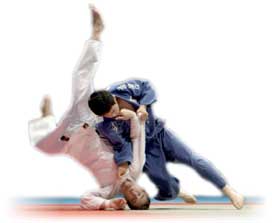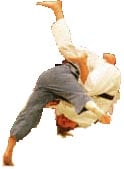 The basic principles of judo are easy to grasp and are essential for the person studying the technique of judo. Judo techniques enable a weak and small man to overcome a large and strong man because they are based on scientific principles such as leverage and balance. The first thing to learn is never to oppose strength to strength. If you do that the stronger man will inevitably win. Remember that when he is on balance he is strong, but off balance he is weak, providing you have retained your own balance to take advantage of his weakness. A man is on balance, you will find, if he stands upright, and keeps his centre of gravity inside a small circle drawn round his feet. Before you execute a throw you must break his balance by getting his center of gravity outside that circle. "Centre of Gravity" is a scientific term, and for those who are not familiar with it, it means the point at which a person's or an object's weight acts. The point at which you could balance him on a support, in plain language. The second principle you should understand and think about is the action of levers. You know how much easier it is to lift a heavy object by putting a crowbar under it. If you rest the end on the ground, have the object a little way up the lever, and lift the other end of the bar, you are using your crowbar as a lever of the second class. If you put a support under your crowbar, put one end under the object and press down on the other end, you are using it as a lever of the first class. The effort you use multiplied by the distance from the point of support (fulcrum) is equal to the resistance you lift multiplied by its distance from the fulcrum. The resistance divided by the effort is called the Mechanical Advantage of the lever. (There is a third class of lever which does not have a Mechanical Advantage, but this will not concern us.) Applying this to turning an opponent about a line drawn perpendicularly down through his middle, you will see that the wider your hands are apart in gripping him for this purpose, the greater will be your Mechanical Advantage. You will be able to see this applied in throws. Get the greatest Mechanical Advantage you can. Dr. Kano stated the principle as "Maximum Efficiency, Minimum Effort". Direction of pulls and timing of attacks are also of paramount importance to success. Forces in JudoWe know that there are many kinds of force around us. How are they made use of in judo? Let us discuss two of them. According to Newton's second law of motion, you have an advantage over your opponent when your body is larger than his. Besides that law, however, there is another factor that gives you advantage over a smaller opponent. This is the large muscular force with which a big man is usually gifted. He can carry a heavy block or lift it easily, whereas the same feat may be difficult for a smaller man. Although we can say that large muscular force is very convenient for breaking the opponent's posture in judo, muscular force alone does not encompass all the forces used in judo. To make use of muscular force normally and effectively, you must study its nature. One of the important facts about judo is that successful employment of techniques is the result of total body muscular movement – as, for example, in the execution of seoinage. The same thing can be said about pinning or strangling. Defensively, too, it might be difficult to save yourself from your opponent's attack were it not for your ability to use all your muscular force. We can therefore understand that the exertion of a strong force means that muscles must act together by the use of the force of the waist and abdominal region. Expert judo is characterized by a large variety of techniques. As you observe, you will notice that the expert makes good use of many kinds of forces. Since judo employs many forces, such as those of gravity, momentum, and friction, you must not mistake muscular force for the only effective one. If you do, your judo will become hard, heavy, slow, and ineffective. It is important to throw your opponent by making use of his loss of balance. One of the laws at work here is the law of gravity. All bodies in the universe attract one another. Now let us consider the application of the law of gravity to judo. The heavier the opponent, the more difficult it is for you to move him horizontally. It is even more difficult for you to move him vertically. On the other hand, a larger gravity acts on him to make him fall. In judo, gravity may be represented as a force pulling the opponent downward. If you want to make him fall, you make him lose his balance; that is, you cause his center of gravity to go outside the base. Then the gravity that acts on him works for you to make him lean or fall. Let's assume that you and your opponent are standing face to face. When your opponent advances towards you to take hold of you by the lapel. At the same time you withdraw as much as your oponent advances. If your oponent is mentally or physically unable to let his advanced foot advance again, he will lean forward, lose his balance, and you will be able to throw him by taking advantage of gravity. Also, it is obvious that the same thing will happen when the stability of the legs supporting the trunk is taken away. When your opponent takes a larger step forward than usual, you may sweep his advanced foot away. By doing this, you will drop him with the force of gravity acting on him directly rather than muscular strength. It may be difficult for you, because of the weight advantage of your opponent, to lift a larger opponent with your arms. But it is easy to support him at the center of gravity with your hips as he leans forward. Look at how a heavier person can be lifted on a seesaw seesaw if you sit further away from the fulcrum. After making your opponent lean forward, support him at the center of gravity with your hips. No matter how much weight he may have, a slight pull can rotate him him over your hips. If your hips are lower than the center of gravity, then your opponent will be top heavy and his own weight will work against him causing him to fall over you. To support your opponent completely at the center of gravity with your hips is the key point of such hip throws as o-goshi. The Aims of PracticeFrom the brief statement of principles above, it will be seen that the immediate aims of practice are three-fold: 1. To learn the techniques. 2. To learn non-resistance, so that the opponent can be made to put himself off balance. 3. To develop speed and timing in the application of the techniques. These are the immediate aims of a beginner, but there are more fundamental aims as well. As you progress, you will find that you reach a point where you can see that an opportunity to throw is going to occur, and you have developed enough speed to take advantage of that opportunity. This is very good, but beyond this, you will reach a stage in which you are practicing with an opponent, and suddenly he is down, without conscious thought on your part. Then your body is automatically reacting in the right way to the situation, and that is true Judo. These are the basic principles of Judo, and can be easily learnt. The actual practice of Judo of course takes much more time and effort.
|


